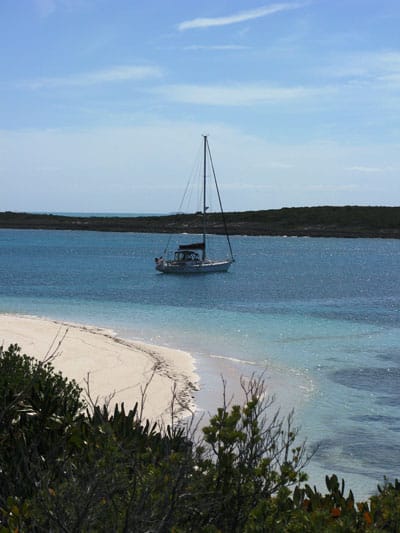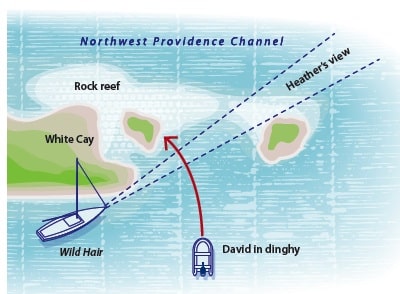
Wild Hair
Though our boat had slipped its anchor and was smashing into the rocky shore of an uninhabited Bahamian island on a stormy February night, that’s not the reason I issued a Mayday distress call. No, I called for help because I saw my husband, David, carried out to sea in our inflatable dinghy armed with nothing but a broken outboard motor, a plastic paddle, a P.F.D., and a feeble headlamp. Luckily, “out to sea” was an illusion. Beyond my line of sight, and in the falling tide, my husband grounded the dinghy on a previously submerged rocky shoal, then walked across the island, through the water, and back to our beached boat. This is the story of my distress call and its aftermath.
The Call
Alone on the boat that night, my first thought was to trigger our 406-megahertz EPIRB, an emergency satellite beacon that we have dutifully registered with NOAA. By sending out a hex code specific to our individual unit, the EPIRB would immediately tell the U.S. Coast Guard where our troubled boat was located, who was likely on board, and the type of vessel for which rescuers should look. EPIRBs provoke an enthusiastic response: Aircraft would’ve been launched and large U.S. Coast Guard cutters would’ve been diverted.

_ Illustration by Tim Barker_
I didn’t activate the beacon, however, because I didn’t want to bring emergency services directly to me. I wanted them to rescue my husband in the dinghy. Instead, I cranked up the electronics, determined our boat’s position and—at 2205 on that brutal night—spoke simultaneously into our VHF and single-sideband microphones.
“Mayday, Mayday, Mayday!” I called. “This is sailing vessel Wild Hair, Wild Hair, Wild Hair. Our current position is north 25 degrees 36 minutes, west 77 degrees 43 minutes. Repeat: We are at north 25 degrees 36 minutes, west 77 degrees 43 minutes. Repeat: north 25 degrees 36 minutes, west 77 degrees 43 minutes. We are west of White Cay in the Berry Islands of the Bahamas. Our vessel is on the rocks. One person is on board the vessel, and one other person has blown out to sea in an inflatable dinghy. Mayday! Mayday! Mayday!”
Silence. After three attempts, I stayed on VHF Channel 16 but changed SSB frequencies, eventually trying 2.1820, 4.1250, 6.2150, and 8.2910. Still hearing no response, I retrieved our month-old satellite phone. Smartly, I’d preprogrammed all of the U.S. Coast Guard emergency phone numbers for the U.S. East Coast into the handset. Unwisely, I forgot—under stress—how to recall the numbers and operate the unit. Without this knowledge, the phone was as useful to me as a paperweight. So again and again I repeated the sequence of calls into the SSB and VHF radios.
At some point, I heard my husband’s voice shout his return. My attention leaped from distress calls to relief to the next emergency at hand: rescuing our boat. Our strategic thinking was interrupted by the crackle of the VHF. The crew of a local cruise ship—the Bahamas Celebration—had heard my VHF call and summoned their captain. His calm and experienced voice was like salve on a wound. I’d been heard. It was comforting to know we weren’t alone. Though his ship was too large to enter our snug harbor, the captain offered to contact the Bahamas Air and Sea Rescue Association on our behalf. But with my husband safely on board and only our boat at risk, we accepted the captain’s personal cellphone number, thanked him for his kindness, and informed him that his services wouldn’t be necessary—yet.
With a signal spotlight, we hailed a sailor about half a mile away who was sharing our harbor. His dinghy had a working outboard. That and a rising tide allowed us to kedge Wild Hair from peril by dawn. After the frontal passage and an extra day’s rest, my husband and I discussed between us the lessons we’d learned from the nasty experience. Then we started putting the nightmare behind us. We had a glorious sail 20 miles south to the populated island of Frazer Hog Cay. It was there that I started to learn the rest of the story.
The Response
When we arrived, everyone seemed genuinely happy to see_ Wild Hair_ and her crew. As we snagged a mooring ball, people came out in their dinghies to greet us and check on our wellbeing. Our Mayday had prompted a buzz of speculation, and theories had persisted unchecked for days. Evidently, both cruisers and Bahamian locals had heard my call for help, but given the storm, none felt in a position to lend assistance.
Astonishingly, we learned that my SSB distress call had skipped the U.S. East Coast entirely. But Petty Officer Adam Harris, manning a U.S. Coast Guard communication station in Kodiak, Alaska, picked it up. Kodiak was the only U.S. Coast Guard station to copy my voice, on frequency 4.1250. Officer Harris recorded only a partial, garbled position statement, figured out our approximate location, and within minutes mobilized the U.S. Coast Guard District Offices in Florida.
The Florida office briefed the Royal Bahamas Defense Force, and a local volunteer rescue boat was deployed that night in 35-knot winds and 13-foot seas. Remarkably, the rescue effort initiated all the way from Alaska came within 20 miles of us. But without a positive fix on our coordinates, their efforts proved to be futile.
Still stunned by this news, I opened our satellite email account to discover that the U.S. Coast Guard’s actions hadn’t ceased. As we’d been designated as a U.S. Coast Guard Search and Rescue case, my inbox was flooded with worried emails from family and friends. Procedurally, once I’d engaged the SAR system, it wouldn’t stop until there was resolution; the U.S. Coast Guard doesn’t close a case until it finds what it’s looking for and either renders assistance or confirms that it’s not needed.
In total, members of the U.S. Coast Guard spent three days tracking us down. After the initial action, Officer Harris turned the case over to Joshua Bouknight, a petty officer OS2 also stationed in Alaska. Like a detective, Bouknight searched the national database and found 12 vessels registered as Wild Hair. He used software to clean up my radio transmission and listened to the call several dozen times. Hearing “One person blown out to sea and one person on board,” Bouknight knew there were only two people involved.
Ruling out larger commercial fishing vessels, he did an online search and found our Adventures of Wild Hair blog. Our dispatches confirmed that our sailing area matched the partial position statement he’d picked up. Furthermore, the blog listed the length and type of our vessel, a Hylas 45.5-foot sloop. Bouknight cross-referenced the boat details with the vessel-registration database and identified us as the boat owners. Our contact information was also listed.
Armed with our names and addresses, Officer Bouknight attempted to call my husband, but our home phone had recently been disconnected. Utilizing an Internet spider, Bouknight opened pages related to my husband and learned of his former employment. From there, he called my husband’s secretary in Wisconsin, and she provided our cellphone number and confirmed that we were sailing. Unfortunately, our U.S.-based cellphone didn’t work in the Bahamas, so this also proved to be a dead end.
Knowing that our children were close friends with the kids of my husband’s business partner, the secretary put Bouknight in contact with my husband’s colleague. Again, the partner confirmed that we were sailing and—after a quick call to his daughter—offered Bouknight our 21-year-old daughter’s phone number. She gave the officer our satellite email address and the phone number of my mother in Arizona.
For safety’s sake, I email my mother our latitude and longitude whenever we arrive at a new location. Through my mother, then, Bouknight was able to confirm our last known whereabouts and our itinerary. This information correlated perfectly with our distress call.
This detective work was the reason why my inbox was flooded with worried emails. Everyone had spent hours and days fearing the worst. Quickly, I got on the satellite phone and—calmly remembering how to operate the unit—started the process of easing minds.
The Aftermath
When I think back on these events, I’m struck by a tangle of emotions. Of course, I’m hugely relieved that David is safe and with me still. I’m chagrined that the clocking wind and simultaneously shifting tide conspired to lift our anchor and put Wild Hair on the rocks, but I’m proud that we—with a little help and a measure of know-how—got out of the predicament.
I regret having prompted a rescue vessel to launch a futile mission in horrible weather, and I’m sickened by the thought that we put someone else needlessly at risk. I feel horrible about the sleepless night I caused the people I hold most dear. Not least, I feel guilty about the precious U.S. Coast Guard resources spent over the course of three days on our behalf.
But Officer Bouknight allayed those concerns. In stunningly compassionate and deftly professional follow-up emails, Officer Bouknight expressed nothing but relief that we were safe and sound. “It happens too often that our best isn’t enough, no matter what we do,” he wrote. “Too much works against us, be it the ticking clock or the wrath of nature.”
After emphatically reassuring me that I took the appropriate actions and even complimenting me on a carefully articulated, clear, and calm Mayday call, Bouknight insisted that no one should hesitate to send a distress call should the need arise. He said, “All Coast Guardsmen feel only relief when they find that a vessel in distress is safe.”
Eventually I learned that I could’ve resolved our SAR case more quickly by simply phoning the closest U.S. Coast Guard unit and telling them that the situation had been addressed and all was well aboard Wild Hair. The agency is structured on a series of ever-broadening tiers so that a message finds its way swiftly to the right person.
The U.S. Coast Guard urges mariners to phone the agency after shooting a flare, sending a voice distress call, or firing off an EPIRB. Follow-up calls help keep Coast Guardsmen out of harm’s way and free the agency’s finite resources so more individuals receive assistance.
I have a heightened respect for the individuals and organization that makes up the U.S. Coast Guard. Humbly refusing to accept accolades, Bouknight said, “I was trained to search for every boat like I had my own family aboard.” Acknowledging the roles of Officer Harris and others, he added, “Everything was made possible by a chain of individuals who operated with consistency and professionalism.”
As a reflection of his deeply earnest commitment to saving lives, Bouknight ends all of his email correspondences with the Latin phrase Dum spiro spero. The translation: “While I breathe, I hope.”
In the last three years, Heather and David Mann have covered more than 6,000 nautical miles aboard their Hylas 45.5 sloop, Wild Hair_, while cruising from Chesapeake Bay and the U.S. East Coast to the Bahamas._








